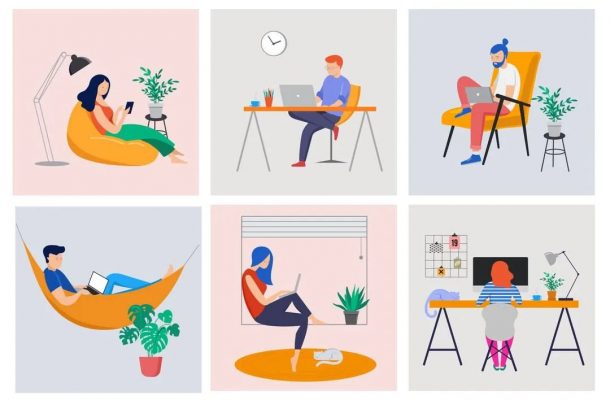Coronavirus is expected to start a working from home revolution for those not on the essential services ‘frontline’, or left unemployed.
While for some this might seem like a working holiday (no commute, enhanced productivity, regular pet pats, or never having to get out of your pyjamas), for others the idea and reality of working from home generates a range of anxieties, practical difficulties and other downsides.
This may be particularly true for people with children at home, cramped or unsuitable workspaces, unhealthy or violent family relationships, other caring responsibilities, and mental health issues, to name but a few challenges.
For many households, these impacts are likely to be gendered. As The Atlantic journalist Helen Lewis recently pointed out: “One of the most striking effects of the coronavirus will be to send many couples back to the 1950s. Across the world, women’s independence will be a silent victim of the pandemic.”

Single-parent households, 82 per cent of which are headed by women in Australia, may find the new working from home arrangements particularly difficult.
Similarly challenged are likely to be dual-income households who now face additional caring responsibilities due to school, kindergarten and daycare closures, and elderly or neighbourhood caring needs.
Given that Australian women earn on average more than $200 less than men per week, and spend 64 per cent of their average weekly working time on unpaid care work compared to 36 per cent for men, there may be a growing temptation to sacrifice women’s jobs in heterosexual coupled households. This would not only maximise the highest household income, but also allow households to play to their existing “strengths”.
Unlike during World War II, when women were called into employment, COVID-19 may call on women to leave their jobs and careers to prioritise the unpaid home-based labour required to unite against this unseen threat.

“Smart wives” (digital assistants, housekeeping robots, social robots, and other AI performing stereotypical and traditional wifely roles) are stepping in to lend a helping hand. But they’re unlikely to quell the “wife drought” that’s plaguing contemporary households. Indeed, now is a time when we need “wives” more than ever.
In order to prevent a mass exodus of primary caregivers from the workforce, aside from those being called to the health crisis frontline, we need a quick overhaul of workplace policy and culture, which some organisations are already moving to enact.
Employers, leaders and managers need to support their staff to juggle the various activities increasingly happening in homes, wherever possible, as many are already doing. While keeping routines, working as normal, or setting up a designated workstation and end time may be desired and recommended, these approaches will not be possible for everyone.
For those who find themselves in unpredictable and non-routine situations, radical flexibility is required. Replicating a 9-to-5 working environment or expectation at home is unlikely to be possible for many. People may need to work whenever they have the opportunity, at odd times, in between other responsibilities, with regular disruptions and distractions, while being sensitive to various moods and stresses.
The new normal
Expectations of productivity or work output will also need to be adjusted, as may working hours and other “normal” parameters. For example, organisations such as the Australian National University have moved to support hours being spread out over the week. More progressively, the university states that if you can manage 25 out of 35 hours per week (pro-rata for part-time), it will be considered a full working week for pay purposes.
In dual-income partnered households, one or both partners may need to officially move to part-time employment. However, this must be allowed for flexibility, with variability in hours possible, and fluid transitions between full and part-time arrangements as the situation unfolds (rather than “locking” people into one arrangement or the other for a designated period of time).
“This isn’t just about supporting women’s employment. If all genders have a variety of “workarounds”, then we can foster a flexible homeplace, to keep as many people in their jobs as possible.”
Some people might need or want to take a temporary break or “hold” on their jobs and careers. More than just a quick two weeks of annual or carer’s leave, this could be implemented as a temporary pause on employment where possible.
Likewise, employers should consider pausing or moderating their probation or productivity expectations for staff, to alleviate additional stress and anxiety, which is rapidly rising in the COVID-19 environment.
So-called “stop-the-clock” policies for primary caregivers, or “performance (or achievement) relative to opportunity” guidelines, which are already commonplace for academic tenure, grants and promotions, provide useful precedents in this regard. These could be adapted to suit the reduced “opportunity” to achieve “normal” workplace (and study) expectations during this time.
This isn’t just about supporting women’s employment. If all genders have a variety of “workarounds”, then we can foster a flexible homeplace, to keep as many people in their jobs as possible.
Some businesses and organisations are transitioning towards this new reality faster than others. But cultural expectations of productivity and working hours may be slower to transition to a new normal, particularly in a country used to delivering vast amounts of unpaid overtime, with increasing job precarity and insecurity.
Radical flexibility won’t suit everyone, of course, and may have other downsides (such as reinforcing the expectation to be constantly available). But it is a practical strategy that many organisations can take right now to support their home force of workers.
This article was published by Lens.













